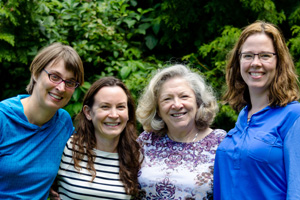
This month, Dr. Kym Ahrens is going to camp with 24 teenagers.
Some people would call that an adventure; others, a challenge.
Ahrens calls it research.
Ahrens, an adolescent medicine specialist and researcher within Seattle Children’s Research Institute’s Center for Child Health, Behavior and Development, is studying whether an intensive, five-day “dose” of a specially designed camp can give teens in foster care the skills they need to steer clear of risky sexual behaviors.
It’s a big deal because teens in foster care are at much higher risk than their peers for unwanted pregnancies and sexually transmitted infections (STIs).
“The statistics are pretty shocking,” says Ahrens.
- By age 17, one in three young women living in foster care is pregnant
- By age 19, that number rises to 50%
- By age 21, it jumps to 71%
- Young men in foster care have a similar risk of becoming young fathers
The pregnancy rate is about three times higher than for teens in stable homes, says Ahrens. The risk of getting STIs is three times to 14 times that of their peers.
Along with traditional camp activities like campfires, hikes and art projects, the 14-to 17-year-olds at Camp Inside-Out will be immersed in group workshops based on dialectical behavioral therapy (DBT), a therapy model that teaches self acceptance and helps build relationship skills.
Last summer, Ahrens and her team of facilitators and counselors did a trial run of Camp Inside-Out with eight teens at Camp Waskowitz in North Bend, Wash.
Ahrens will follow that group – along with this year’s campers and their successors in years to come – to see if the skills they learn insulate them from risky sexual behavior.
Using the system for good
Foster care is more than an academic interest for Ahrens. Her first brush with the system was during medical school when she volunteered for the Big Sister program and was matched with a teenager in foster care.
“The experience changed me,” she says. “I knew then that I wanted to specialize in adolescent medicine and focus on high-risk youth exposed to early adversity.” It set in motion her career studying and caring for teens in foster care.
“This is an under-studied group, partly because it’s challenging to get approval to do research with them, and partly because you have to invest a lot of time getting to know the foster care system,” she says. “But, if you get to know it well you can use the foster care system to do a lot of good.”
A lot of good is exactly what Ahrens is doing, says Sheila Wilson, a social worker for Washington’s Department of Social and Health Services (DSHS) and one of Kym’s inside guides to the system.
“Kym is tackling a problem that my unit has been struggling with since the day we started,” says Wilson. “At one point, I had six teen moms on my caseload, and they all got pregnant while they were in foster care. That’s not okay. Kym tapped into something we really needed help with.”
Away from cell phones and other distractions
It was Wilson’s idea to turn Ahrens’ original research idea – for a once-a-week program in the city – into a sleep-away camp.
Wilson helped Ahrens find campers for last year’s pilot and has been instrumental in filling this year’s 24 spots. She’s had some help from last year’s campers. “Just last week, I heard a young woman who was there last year selling the concept to other kids,” she says. “That was nearly a whole year after the experience.”
Feedback from the pioneering group helped Ahrens’ team tweak the curriculum for this summer. “They wanted to be there longer, so this year camp is five days instead of four,” says Kym. “They wanted shorter group sessions and longer activities, so we changed that, too.” She will continue to make changes based on feedback from teens.
Taking it to the real world
The switch to longer activities and shorter sessions means that this year’s campers will have more time to practice what they learn, says Stefanie Sugar, a Seattle-based therapist who helped design Camp Inside-Out’s learning sessions.
For instance, campers might learn in the morning about ways to communicate effectively and use those skills negotiating an obstacle course that afternoon. “We’ll be there to coach them through it,” says Sugar.
When the teens get home from camp, says Wilson, “they can use the same strategies for negotiating their way out of rooms or relationships or parties.”
Seeds take root
Ahrens never imagined her research path would lead her to camp, but she’s very happy to find herself there. “It fits me really well,” she says.
She expects the study – and the camp – to continue for years. “We’re also developing a plan for a control camp focused on sports so we can eventually do a randomized, controlled trial” to compare the outcomes of the therapy-based camp with those of a traditional camp program.
It’s good to have a long time horizon when you’re working with adolescents, she adds.
She should know – she’s 15 years into her relationship with her “little sister,” who’s now 28. “Watching her grow in some profound ways has been an amazing impetus for me,” says Ahrens. “It helps to see that the seeds you’re sowing can take root.”

